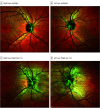Severe Spaceflight-Associated Neuro-Ocular Syndrome in an Astronaut With 2 Predisposing Factors
- PMID: 39052244
- PMCID: PMC11273286
- DOI: 10.1001/jamaophthalmol.2024.2385
Severe Spaceflight-Associated Neuro-Ocular Syndrome in an Astronaut With 2 Predisposing Factors
Abstract
Importance: Understanding potential predisposing factors associated with spaceflight-associated neuro-ocular syndrome (SANS) may influence its management.
Objective: To describe a severe case of SANS associated with 2 potentially predisposing factors.
Design, setting, and participants: Ocular testing of and blood collections from a female astronaut were completed preflight, inflight, and postflight in the setting of the International Space Station (ISS).
Exposure: Weightlessness throughout an approximately 6-month ISS mission. Mean carbon dioxide (CO2) partial pressure decreased from 2.6 to 1.3 mm Hg weeks before the astronaut's flight day (FD) 154 optical coherence tomography (OCT) session. In response to SANS, 4 B-vitamin supplements (vitamin B6, 100 mg; L-methylfolate, 5 mg; vitamin B12, 1000 μg; and riboflavin, 400 mg) were deployed, unpacked on FD153, consumed daily through FD169, and then discontinued due to gastrointestinal discomfort.
Main outcomes and measures: Refraction, distance visual acuity (DVA), optic nerve, and macular assessment on OCT.
Results: Cycloplegic refraction was -1.00 diopter in both eyes preflight and +0.50 - 0.25 × 015 in the right eye and +1.00 diopter in the left eye 3 days postflight. Uncorrected DVA was 20/30 OU preflight, 20/16 or better by FD90, and 20/15 OU 3 days postflight. Inflight peripapillary total retinal thickness (TRT) peaked between FD84 and FD126 (right eye, 401 μm preflight, 613 μm on FD84; left eye, 404 μm preflight, 636 μm on FD126), then decreased. Peripapillary choroidal folds, quantified by surface roughness, peaked at 12.7 μm in the right eye on FD154 and 15.0 μm in the left eye on FD126, then decreased. Mean choroidal thickness increased throughout the mission. Genetic analyses revealed 2 minor alleles for MTRR 66 and 2 major alleles for SHMT1 1420 (ie, 4 of 4 SANS risk alleles). One-week postflight, lumbar puncture opening pressure was normal, at 19.4 cm H2O.
Conclusions and relevance: To the authors' knowledge, no other report of SANS documented as large of a change in peripapillary TRT or hyperopic shift during a mission as in this astronaut, and this was only 1 of 4 astronauts to experience chorioretinal folds approaching the fovea. This case showed substantial inflight improvement greater than the sensitivity of the measure, possibly associated with B-vitamin supplementation and/or reduction in cabin CO2. However, as a single report, such improvement could be coincidental to these interventions, warranting further evaluation.
Conflict of interest statement
Figures




References
-
- National Aeronautics and Space Administration . Risk of spaceflight-associated neuro-ocular syndrome (SANS). Accessed February 20, 2024. https://humanresearchroadmap.nasa.gov/evidence/reports/SANS.pdf
Publication types
MeSH terms
Substances
Supplementary concepts
LinkOut - more resources
Full Text Sources

